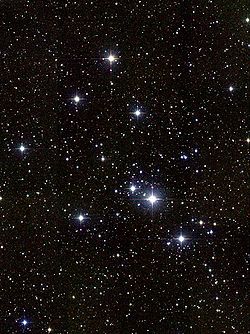- Messier 41
-
Messier 41 
Credit: 2MASS/NASAObservation data (J2000 epoch) Constellation Canis Major Right ascension 06h 46.0m[1] Declination -20° 46′[1] Distance 2,300 ly[2] (710 pc) Apparent magnitude (V) 4.5[1] Apparent dimensions (V) 38 arcmin[2] Physical characteristics Radius 12.5 ly Estimated age 190-240 million yrs[citation needed] Other designations M41,[1] NGC 2287[1] See also: Open cluster, List of open clusters Messier 41 (also known as M41 or NGC 2287) is an open cluster in the Canis Major constellation. It was discovered by Giovanni Batista Hodierna before 1654 and was perhaps known to Aristotle about 325 BC.[3] M41 lies about four degrees almost exactly south of Sirius. It contains about 100 stars including several red giants, the brightest being a spectral type K3 giant near the cluster's center. The cluster is estimated to be moving away from us at 23.3 km/s.[1] The diameter of the cluster is between 25 and 26 light years. Its age is estimated at between 190 and 240 million years old. M41 is also referred to as NGC 2287.
Walter Scott Houston describes the appearance of the cluster in small telescopes:[4]
Many visual observers speak of seeing curved lines of stars in M41. Although they seem inconspicuous on photographs, the curves stand out strongly in my 10-inch [reflecting telescope], and the bright red star near the center of the cluster is prominent.
See also
- New General Catalogue
- Messier object
- List of open clusters
References
- ^ a b c d e f "SIMBAD Astronomical Database". Results for Messier 41. http://simbad.u-strasbg.fr/Simbad. Retrieved 2006-12-21.
- ^ a b "Messier Object 41". SEDS. http://www.seds.org/messier/m/m041.html. Retrieved 2009-12-10.
- ^ M41 possibly recorded by Aristotle
- ^ Houston, Walter Scott (2005). Deep-Sky Wonders. Sky Publishing Corporation. ISBN 1931559236.
External links
- Messier 41 on WikiSky: DSS2, SDSS, GALEX, IRAS, Hydrogen α, X-Ray, Astrophoto, Sky Map, Articles and images
- Messier 41, SEDS Messier pages
- NightSkyInfo.com - M41
- M41 Hires LRGB CCD Image
- ^ a b c d e f "SIMBAD Astronomical Database". Results for Messier 41. http://simbad.u-strasbg.fr/Simbad. Retrieved 2006-12-21.
- ^ a b "Messier Object 41". SEDS. http://www.seds.org/messier/m/m041.html. Retrieved 2009-12-10.
- ^ M41 possibly recorded by Aristotle
- ^ Houston, Walter Scott (2005). Deep-Sky Wonders. Sky Publishing Corporation. ISBN 1931559236.
Coordinates:
 06h 46.0m 00s, −20° 46′ 00″
06h 46.0m 00s, −20° 46′ 00″Messier objects List M1 · M2 · M3 · M4 · M5 · M6 · M7 · M8 · M9 · M10 · M11 · M12 · M13 · M14 · M15 · M16 · M17 · M18 · M19 · M20 · M21 · M22 · M23 · M24 · M25 · M26 · M27 · M28 · M29 · M30 · M31 · M32 · M33 · M34 · M35 · M36 · M37 · M38 · M39 · M40 · M41 · M42 · M43 · M44 · M45 · M46 · M47 · M48 · M49 · M50 · M51 · M52 · M53 · M54 · M55 · M56 · M57 · M58 · M59 · M60 · M61 · M62 · M63 · M64 · M65 · M66 · M67 · M68 · M69 · M70 · M71 · M72 · M73 · M74 · M75 · M76 · M77 · M78 · M79 · M80 · M81 · M82 · M83 · M84 · M85 · M86 · M87 · M88 · M89 · M90 · M91 · M92 · M93 · M94 · M95 · M96 · M97 · M98 · M99 · M100 · M101 · M102 · M103 · M104 · M105 · M106 · M107 · M108 · M109 · M110See also  Book:Messier objects ·
Book:Messier objects ·  Category:Messier objects
Category:Messier objects  Portal:AstronomyCategories:
Portal:AstronomyCategories:- Open clusters
- Canis Major constellation
- Messier objects
- NGC objects
- Orion arm
- Star cluster stubs
Wikimedia Foundation. 2010.
